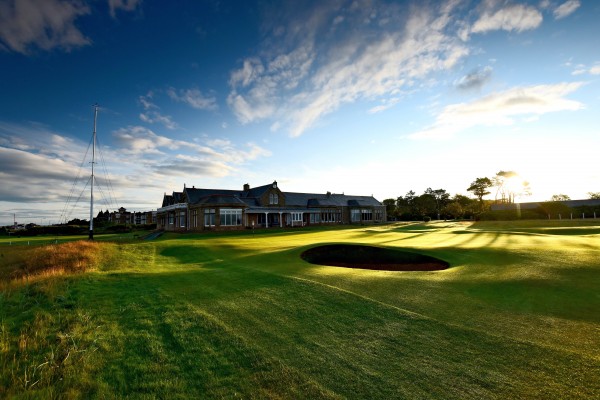
FOR the ninth time in 93 years, the Open Championship returns to Royal Troon Golf Club from July 14-17.
Founded in 1878, Royal Troon is renowned as one of the greatest links courses.
The Old Course represents a stern golfing examination and, in particular, the inward half of Royal Troon is widely accepted as the most demanding of any golf course on the championship rota.
Here is Inside Golf’s A to Z guide to the 138-year-old club and course ahead of The Open.
A is for Americans. The Yanks have a good record at Royal Troon having won the last six of the eight Open championships there. They are Arnold Palmer (1962), Tom Weiskopf (’76), Tom Watson (’82), Mark Calcavecchia (’89), Justin Leonard (’97) and Todd Hamilton (2004). See E and L for other winners.
B is for bunkers. There are 94 bunkers on the course – 58 on the front nine, including 11 on the second hole, and 36 on the back nine. Holes 10 and 13 don’t have any bunkers.
C is for Claret Jug. The trophy is 512mm tall and weights 2.45kgs. Many Open champions drink from the Jug. Ian Baker-Finch, who won the Open at Royal Birkdale in 1991, drank red wine from the Jug.
D is for disaster. In 1989, Greg Norman fired a final round 64 to get in the playoff with Mark Calcavecchia and Wayne Grady. On the final playoff hole, the Shark’s 284m drive found a trap. He gambled, the ball smashed into the bunker’s face and limped into another. Norman thinned his next shot and the ball careered out of bounds. Calcavecchia took home the title.
E is for Englishman. The first and only Englishman to win the Open at Royal Troon is Arthur Havers, who edged out Walter Hagan by a shot in 1923.
F is for free…as in accommodation. An R&A initiative, the next generation of golf fans under the age of 25 attending the 145th Open at Royal Troon will be able to book free accommodation at The Open Camping Village. It will feature two-, four- and six-person pre-pitched tents along with inflatable camping beds.
G is for green fees. One round on the Championship Course (Monday, Tuesday and Thursday) is £220 ($445) per golfer between April 18 and September 8. From September 12 to October 6 it’s £165 ($334). Maximum handicap – men 20, women 30.
H is for Hamilton…as in Todd. Todd Hamilton, the quiet American, won the 2004 Open at Royal Troon when he defeated Ernie Els in a playoff. Until his win, Hamilton had made just one Open cut when he tied for 45th in 1996.
I is for Inclement…as in weather. In July, the normal weather in Troon is 15.1°C with the warmest being 19.4°C and the coldest 10.8°C. The average rainfall in July is 20 days.
J is for Justin and Jesper. At Royal Troon in 1997, Jesper Parnevik held a two-shot lead after 54 holes and a five-shot lead over eventual winner Justin Leonard. The American fired a final round 65 relegating Swede Parnevik (73) to second place alongside Darren Clarke.
K is for knowledge. Arnold Palmer, winner of the British Open at Troon in 1962, believes the skill of the straight drive is more important at Royal Troon than the strength needed for extra long drives. (See M and T).
L is for Locke…as in Bobby. In 1950, the South African shot nine-under to become the second Open champion at Royal Troon. He took home £900.
M is for motto. Royal Troon Golf Club’s motto is Tam Arte Quam Marte, which is Latin for As much by skill as by strength.
N is for nearly (Aussie) men. Three Australians have finished runner-up in The Open at Royal Troon. Norman and Grady lost a playoff to Mark Calcavecchia in 1989 and Kel Nagle was second to Arnold Palmer in 1962.
O is for over par. Only one Open champion has finished over par at Royal Troon. In 1923, champion Arthur Havers hoisted the trophy after finishing seven-over-par.
P is for prizemoney. The Open at Royal Troon carries prizemoney of $A12.9m. The winner will take home more than $A2.3m.
Q is for qualifying. More than 2500 golfers play qualifiers across five continents over seven months for the chance to compete in the 156-man field at the Open Championship. Matt Jones, Rod Pampling and Nick Cullen will be at Royal Troon after qualifying via the Australian Open.
R is for rookie. No player making their debut at Royal Troon has won there although nine players have won the Open at their first attempt – the last being Ben Curtis at Royal St George’s in 2003.
S is for shortest hole. Royal Troon boasts the shortest hole on the Open rota, the famous eighth hole known as the Postage Stamp because of its tiny green. This 123-yard (112m) hole is where Gene Sarazen had a hole-in-one at age 73 during the 1973 Open and where West German amateur Hermann Tissies took a 15 in the 1950 British Open.
T is for tip on how to play Royal Troon. “To win (The Open at Royal Troon) you have to drive it in the fairway,” 1962 champion Arnold Palmer said. “If you are consistently in the rough, forget it. The greens are small. It’s not a tremendously long course. It’s more keeping the ball in the right spots all the time and hitting some good iron shots into the little greens.” Tip 2: this year’s winner Branden Grace.
U is for under par. Mark Calcavecchia holds The Open record at Royal Troon with 13-under par winning total. That’s one better than Justin Leonard (1997), Tom Weiskopf (1973) and Arnold Palmer (1962).
V is for venue. Royal Troon has hosted The Open eight times in 1923, ’50, ’62, ’73, ’82, ’89, ’97 and 2004.
W is for Watson and Weiskopf…as in Tom. Watson (four-under par) and Weiskopf (12-under) won The Open at Royal Troon in 1982 and 1973 respectively.
X is for X (cross) it off your bucket list. Play Royal Troon then hit the high street where there are many local shops and cafés. Who knows, you might run into a famous resident, Colin Montgomerie.
Y is for yardage. Royal Troon is a par-71 layout stretching to 7208 yards (6591m). The shortest hole is the Postage Stamp eight at 123y (112m) and the longest is the par-5 sixth at 601y (550m).
Z is Zach as in Johnson. The American will arrive at Royal Troon as the defending champion after edging out Marc Leishman and Louis Oosthuizen in a playoff at St Andrews last year.




